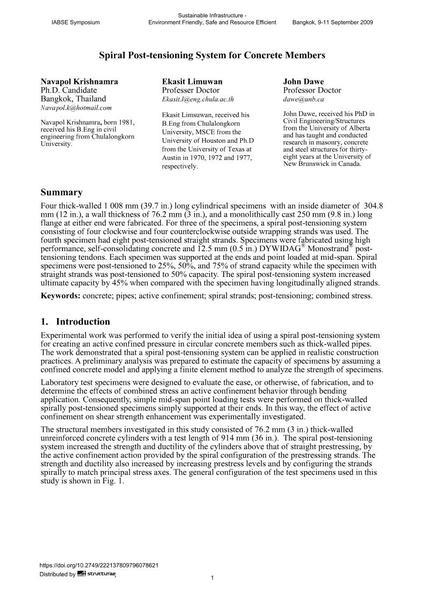Spiral Post-tensioning System for Concrete Members

|
|
|||||||||||
Bibliographic Details
| Author(s): |
Navapol Krishnamra
Ekasit Limuwan John Dawe |
||||
|---|---|---|---|---|---|
| Medium: | conference paper | ||||
| Language(s): | English | ||||
| Conference: | IABSE Symposium: Sustainable Infrastructure - Environment Friendly, Safe and Resource Efficient, Bangkok, Thailand, 9-11 September 2009 | ||||
| Published in: | IABSE Symposium Bangkok 2009 | ||||
|
|||||
| Page(s): | 72-79 | ||||
| Total no. of pages: | 8 | ||||
| Year: | 2009 | ||||
| DOI: | 10.2749/222137809796078621 | ||||
| Abstract: |
Four thick-walled 1 008 mm (39.7 in.) long cylindrical specimens with an inside diameter of 304.8 mm (12 in.), a wall thickness of 76.2 mm (3 in.), and a monolithically cast 250 mm (9.8 in.) long flange at either end were fabricated. For three of the specimens, a spiral post-tensioning system consisting of four clockwise and four counterclockwise outside wrapping strands was used. The fourth specimen had eight post-tensioned straight strands. Specimens were fabricated using high performance, self-consolidating concrete and 12.5 mm (0.5 in.) DYWIDAG® Monostrand® post- tensioning tendons. Each specimen was supported at the ends and point loaded at mid-span. Spiral specimens were post-tensioned to 25%, 50%, and 75% of strand capacity while the specimen with straight strands was post-tensioned to 50% capacity. The spiral post-tensioning system increased ultimate capacity by 45% when compared with the specimen having longitudinally aligned strands. |
||||
| Keywords: |
concrete post-tensioning tubes pipes active confinement spiral strands combined stress
|
||||
